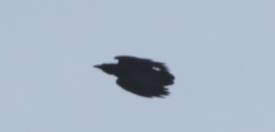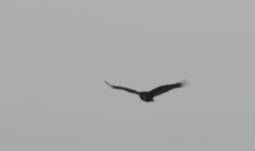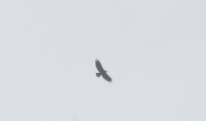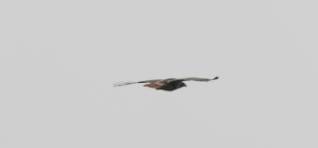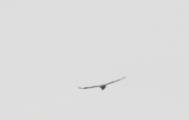Tussey Mountain Spring Hawkwatch 2009 Quiz 2
To see each answer, move the cursor over the word "Answer" (don't click) below each picture.
A classic look at an American Raven folding its wings for a maneuver.
You can see its big bill and the ruff on its neck.
A classic look at a Red-tailed Hawk gliding away. Note the
bulging secondaries. If you learn this look, you will be able to identify
many high-flying redtails at a glance.
This is a distant Golden Eagle. Note its long wings.
Golden eagles commonly exhibit a slight dihedral when in a soar,
as shown by this bird. Even though it has a dihedral, there is
no kink in the wing - it's as if the whole wing is stretching out.
Here is a dark-colored bird in a dihedral that resembles #3,
but this a Turkey Vulture. If you suspected golden eagle for this bird,
that is understandable - goldens and TVs can show similar profiles.
You can see the little head on this Turkey Vulture, but also
see the same look as on bird #4. The wings jut up from the body,
then level off half way out, with primaries tipping up.
Besides turkey vultures being great foolers, American Ravens, like this
one, can be also be foolers. Jon Kauffman described a distant raven
as having the head of a bald eagle and wings of a peregrine.
A classic look at a distant soaring Golden Eagle. Note the
long wings and tail longer than the head. This bird is the same
one as in #3. This bird also shows another golden eagle trait that
can help you ID a far-away bird: a slight pinching-in where the back
of its wings meet the body. You can see this better on the blow-up
of this picture shown after the bonus picture. Bald Eagles
don't exhibit this pinching-in.
See the red tail of this Red-tailed Hawk going away.
They often fly with their wing tips up, as on the right wing of
this bird. Red-tails can sometimes seem to have a hunch-backed
appearance when moving slowly.
This was a trick question, because this bird is a particularly
flat-winged Turkey Vulture. You can probably identify 90%
of turkey vultures right away, but don't give up.
Every year, distant TVs turn into eagles and vice-versa.
A bird with a long and bent wing crossing the ridge.
It isn't a raptor, but a Ring-billed Gull.
